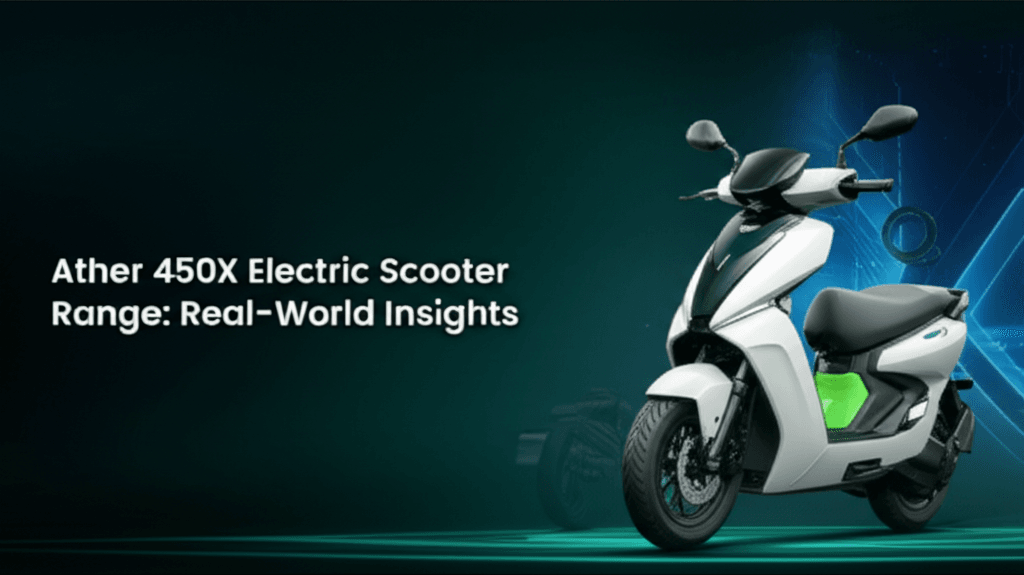The Ather 450X is one of the most popular premium electric scooters in India, celebrated for its performance, connected features, and urban practicality. But for most buyers, the big question remains: What is the real-world range of the Ather 450X, and how does it vary in everyday conditions? In this comprehensive guide, we go beyond spec-sheet numbers to deliver real-world insights on the Ather 450X range, charging behaviour, riding modes, factors affecting efficiency, and practical tips to get more kilometres per charge. Whether you commute daily, plan occasional long rides, or are comparing EVs for your next purchase, this article serves as your go-to range handbook.
Introduction: Understanding Real-World Range vs. Claimed Numbers
The Ather 450X is engineered for city commuting with a blend of power, tech, and efficiency. While manufacturers publish certified range figures based on standardized test cycles like IDC (Indian Driving Cycle) or ICAT, real-world riding conditions often differ. Traffic, road gradients, ambient temperature, load, tyre pressure, and riding style all influence how far a scooter can go on a single charge. The Ather 450X, across its generations, typically claims between 100–150 km of IDC-certified range depending on the model year and battery pack. However, actual range in cities tends to be lower, though still highly usable for daily urban rides.
This article breaks down what riders typically experience in the real world, including data-driven scenarios, mode-wise range, city vs. highway riding, and charging strategies. We also provide tips to maximize efficiency without compromising on ride quality. If you’re considering the Ather 450X or want to get the most out of yours, these practical insights will help you ride smarter and go farther.
What Affects the Ather 450X Range in Everyday Use?
Understanding what influences your real-world range helps build better riding and charging habits. The following factors have the most significant impact:
1. Riding Mode and Throttle Behavior
The Ather 450X typically offers multiple ride modes such as Eco, SmartEco, Ride, Sport, and Warp (availability depends on software version and model year). Each mode adjusts power delivery and top speed, directly affecting consumption.
- Eco/SmartEco: Prioritizes efficiency with moderated acceleration. Best for steady urban commuting.
- Ride: Balanced output suitable for daily use with decent pep and solid efficiency.
- Sport/Warp: Maximum performance with quicker throttle response and higher top speed—expect more battery usage per km.
Tip: Smooth throttle and lower peak acceleration events lead to lower Wh/km and longer range.
2. Traffic and Average Speed
In stop-and-go city traffic, electric scooters often perform efficiently due to regenerative braking opportunities and low idle losses. However, frequent hard accelerations can eat into range. On the other hand, cruising at a steady 35–45 km/h usually yields excellent efficiency. Sustained high speeds (above ~60 km/h) increase aerodynamic drag exponentially, reducing range.
3. Temperature and Weather
Battery chemistry is sensitive to temperature. Extreme cold can reduce available capacity and slow charging. Very hot conditions can trigger thermal management measures, mildly impacting performance or charging speeds. Most Indian cities fall within the scooter’s optimal operating envelope, but seasonal changes may shift real-world range by a few percent.
4. Load, Terrain, and Tyre Pressure
- Rider + Pillion + Cargo: Higher load increases consumption.
- Inclines: Hilly rides require more energy; plan charging accordingly.
- Tyre Pressure: Underinflation increases rolling resistance; check monthly for optimal range and safety.
5. Software and Firmware Updates
Ather periodically releases OTA updates to improve efficiency algorithms, throttle mapping, regenerative braking behavior, and range estimation. Keep your scooter updated to benefit from incremental improvements and more accurate Distance-to-Empty (DTE) predictions.
Real-World Range: Mode-by-Mode Expectations
While exact numbers vary by battery pack version and conditions, the following estimates reflect typical urban usage reported by riders under mixed conditions with mindful riding:
| Ride Mode | Typical Real-World Range (km) | Use Case | Notes |
|---|---|---|---|
| Eco / SmartEco | 90–110 | Maximum efficiency, calm city commutes | Best for predictable routes; gentle throttle recommended |
| Ride | 75–95 | Balanced performance and range | Ideal daily city mode with moderate overtakes |
| Sport | 60–80 | Quick acceleration, denser traffic agility | Higher consumption due to stronger throttle response |
| Warp | 45–65 | Maximum performance | Frequent spirited rides will reduce range |
Important: These are indicative ranges for temperate weather, mostly flat terrain, single rider (~70–85 kg), and mixed urban speeds. Highway or ring-road cruising at higher speeds may push the number down. Conversely, careful Eco-mode riding on flat routes can exceed the listed values.
City vs. Peripheral Highway Riding
- Dense Urban: Regenerative braking and lower average speeds help efficiency, especially in Eco/Ride modes.
- Peripheral Highways: Continuous high-speed runs reduce range due to aerodynamic drag. Plan for fewer charging stops or switch to Ride mode with a steady throttle.
Charging the Ather 450X: Time, Options, and Strategy
Charging strategy strongly influences convenience and range confidence. The Ather 450X supports both home charging and public fast charging with the Ather Grid network in many cities.
Home Charging
- Charger Type: Standard home charger (typically 3-pin or wall-mounted).
- 0–80% Time: Around 3–4 hours depending on model and supply.
- 0–100% Time: 4–5.5 hours in typical conditions.
- Best Practice: Regularly charge to 80–90% for daily urban use; top up fully before longer rides.
Ather Grid Fast Charging
- Availability: Present in many Indian metros and Tier-1/2 cities; coverage is expanding.
- Speed: Significant top-up in 30–45 minutes; exact rates vary by location and battery state.
- Use Case: Mid-day top-ups during errands or extended commutes; reduces range anxiety.
Charging Strategy Tips
- Top-Up Mindset: Treat your scooter like a smartphone—plug in at home overnight and opportunistically at work or public chargers.
- Avoid Extreme Lows Frequently: While occasional low SOC is fine, repeatedly going under ~10% can add stress to the battery over time.
- Thermal Considerations: In very hot weather, allow a short cooldown after spirited rides before fast charging.
Maximizing the Ather 450X Range: Proven Techniques
Range optimization does not require sacrificing ride quality. These practical techniques deliver measurable gains:
Optimize Your Mode Mix
- Use Ride or SmartEco for daily commuting to balance agility and efficiency.
- Reserve Warp for short bursts—quick overtakes and fun stretches.
- In slow, predictable traffic, Eco shines by stretching every percent of charge.
Throttle, Braking, and Anticipation
- Feather the throttle: Smooth inputs reduce energy spikes.
- Anticipatory riding: Look ahead to avoid unnecessary accelerations and heavy braking.
- Use regen: Ease off early to let regenerative braking recover small amounts of energy.
Maintain Your Scooter
- Tyre pressure: Keep within recommended PSI for lower rolling resistance and safer handling.
- Firmware updates: Install updates promptly for improved efficiency and accurate range estimates.
- Wheel alignment and bearings: Ensure minimal mechanical drag.
Route and Weather Planning
- Plan flatter routes where possible; even small inclines increase energy draw.
- Avoid strong headwinds on exposed stretches when you can; aerodynamics matter more than most riders expect.
- Time your charge: Charge during cooler parts of the day in very hot climates to reduce thermal load.
Real-World Scenarios and Case Studies
To make range more tangible, here are representative scenarios from typical Ather 450X usage patterns. These are not official figures but reflect consolidated rider experiences across mixed Indian urban conditions.
Scenario 1: Inner-City Commuter (20–30 km/day)
Profile: Single rider, 15 km one-way commute with moderate traffic, frequent signals, and speeds of 25–45 km/h.
- Mode: Ride with occasional Eco in congestion
- Observed Range: 80–95 km per full charge
- Charging: Home top-up every 2–3 days
- Key Tip: Maintain steady throttle; charge to ~90% nightly for convenience
Scenario 2: Peripheral Ring Road Rider (35–50 km/day)
Profile: Mixed flyovers and open stretches, cruising at 50–65 km/h, fewer stops.
- Mode: Ride or Sport for quicker merges
- Observed Range: 65–85 km per charge, depending on speed and wind
- Charging: Alternate-day home charging or mid-week fast charge
- Key Tip: Keep speeds under ~60 km/h where possible to reduce drag penalties
Scenario 3: Performance Enthusiast (Weekend Sprints)
Profile: Aggressive acceleration, Warp mode use, short spirited rides.
- Mode: Warp predominately, occasional Sport
- Observed Range: 45–65 km per charge
- Charging: Frequent top-ups; consider Ather Grid near popular routes
- Key Tip: Combine Warp bursts with Eco or Ride cruising to extend total trip length
Scenario 4: Two-Up Commute with Hilly Sections
Profile: Rider + pillion, mild gradients, mixed traffic.
- Mode: Ride for control; Eco on flat sections
- Observed Range: 60–80 km per charge
- Charging: Daily or alternate-day top-ups recommended
- Key Tip: Maintain tyre pressure at the higher end of the recommended band
Comparing Ather 450X Range with Alternatives
If you’re cross-shopping electric scooters, it helps to view the Ather 450X in context. While exact specs vary by variant and year, here’s a high-level comparison of typical real-world ranges among popular premium electric scooters under balanced riding:
| Model | Battery (Approx.) | Ride Modes | Typical Real-World Range | Fast Charging Network |
|---|---|---|---|---|
| Ather 450X | ~3–3.7 kWh (varies by gen/variant) | Eco/SmartEco, Ride, Sport, Warp | 45–110 km depending on mode/conditions | Ather Grid (growing footprint) |
| Ola S1 Pro | ~4 kWh | Eco, Normal, Sport, Hyper | 60–120 km | Public AC; fast charging rollout evolving |
| TVS iQube ST | ~4.5 kWh | Eco, Power | 70–110 km | Primarily home/public AC |
| Bajaj Chetak (New) | ~3 kWh | Eco, Sport | 65–95 km | Public AC |
Note: These are indicative comparisons for informational purposes and may vary by city, firmware, terrain, and rider behavior. The Ather 450X stands out for its responsive power delivery, precise ride modes, robust connectivity, and a dedicated fast-charging network that enhances real-world usability.
Battery Health, Degradation, and Long-Term Range
Like all lithium-ion batteries, the Ather 450X battery will experience gradual capacity loss over years of usage. The rate depends on charging habits, climate, storage, and average state of charge (SOC).
What Owners Can Expect
- Early Years: Minimal, often imperceptible loss with typical commuting.
- 3–5 Years: Some capacity fade may be noticeable in total range, but day-to-day usability remains high for urban rides.
- Management: Ather’s battery management system helps protect longevity with thermal controls and charge safeguards.
How to Preserve Battery Health
- Moderate SOC: Frequent full charges are fine, but for daily use, staying between ~20%–90% is gentle on the pack.
- Temperature: Park in shade when possible; avoid prolonged exposure to extreme heat.
- Charging Rhythm: Avoid leaving the scooter at 0% or 100% for extended periods.
Practical Examples and Real-World Applications
Here are actionable examples to translate insights into everyday decisions:
Example 1: Planning a 70 km Day with Two Stops
- Route: 35 km morning commute, 35 km return.
- Strategy: Start at 90–100% SOC. Use Ride mode. Top up 20–30% at an Ather Grid near the workplace during lunch.
- Outcome: Comfortable buffer even with occasional Sport mode bursts.
Example 2: Errand Day with 10–15 Short Trips
Route: 2–7 km per trip, frequent stops, mixed traffic.

